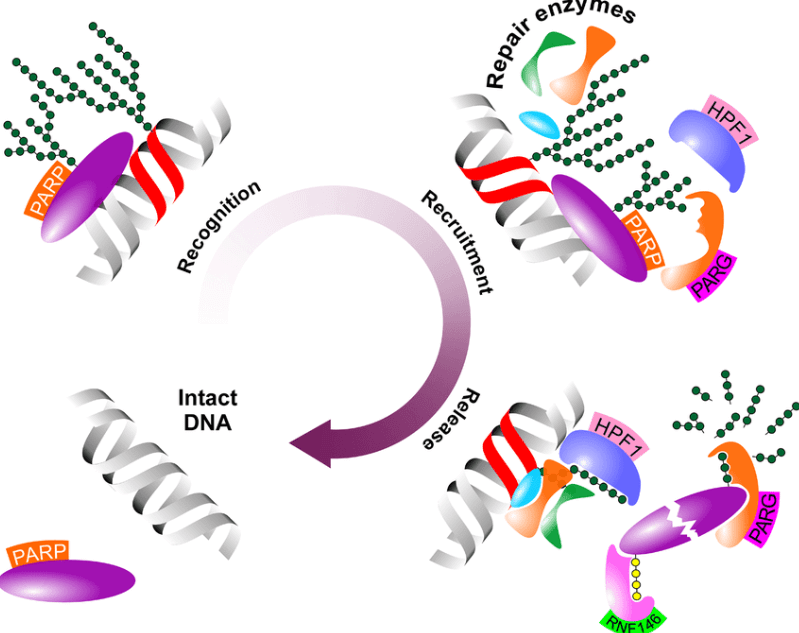Abstract: Poly(ADP-ribose) polymerase (PARP) is located in the nucleus and belongs to the DNA-repairing enzyme under stress condition. PARP1 plays an important role in DNA damage repair by labelling DNA damage sites and recruiting relevant DNA repair proteins.
Keywords: DNA Damage Repair, DNA-repairing Enzyme, PARP1 Protein
1. DNA Damage Repair Pathways
Prof. Lior Appelbaum and his team in the research about zebrafish and mammals find the cerebral nerve in the conscious state will continuously accumulate DNA damage and recruit PARP1 protein to repair neurons. When cumulative damage increases to a certain level, the brain receives the signal of PARP1 protein and then is asleep. PARP1 protein will further recruit DNA repair protein to fix the damage. Prof. Appelbaum said "our research shows PARP1 pathway can send signals to the brain, induce the sleep for DNA repair, and regulate the balance between neuronal DNA damage and repair". This finding shows the relationship among sleep disorder, ageing and neurodegenerative diseases, and prepares for developing relevant drugs for sleep disorders in the future as well.

2. Cause of DNA Damage
Researchers guess the increase of peak cumulative DNA damage may be the driving factor for triggering the sleeping of mammals. Prof. Appelbaum and his team conduct the zebrafish research. They find zebrafish requires more sleep with the increase of DNA damage. Meanwhile, researchers also find once cumulative DNA damage is higher than the peak value, the zebrafish will fall asleep. Then, neuronal DNA damage decreases. The zebrafish requires 6 hours of sleep to repair DNA damage at least. If the amount of sleep is not enough, DNA damage can't be repaired completely. The zebrafish continues to sleep in daytime.
3. PARP1 DNA Repair
Cumulative DNA damage plays an central role in driving the sleep of brain. PARP1 protein is an very important substance for DNA repair. The zebrafish research shows increasing the expression of PARP1 can promote the sleep of zebrafish by genetics or pharmacology and improve sleep-dependent DNA repair. To the contrary, the inhibition of PARP1 protein activity prevents the DNA damage and repair. Even though neuronal DNA damage is above the threshold, the zebrafish can't fall asleep by feeling the exhaustion. PARP1 protein is cerebral susceptibility to DNA damage and also the key driving factor for sleep.
4. Recommended Antibodies
- 【FNab06151】anti- PARP1 antibody
- 【FNab09939】anti- PARP1 antibody
- 【FNab00484】anti- APLF antibody
- 【FNab09553】anti- XRCC2 antibody
- 【FNab09554】anti- XRCC4 antibody
- 【FNab04661】anti- KU70 antibody
- 【FNab09555】anti- XRCC5/Ku80 antibody
- 【FNab05213】anti- MLH1 antibody
- 【FNab04774】anti- LIG4 antibody
- 【FNab00736】anti- ATR antibody
- 【FNab00942】anti- BRCA1 antibody
- 【FNab00943】anti- BRCA1 antibody
- 【FNab01654】anti- Chk2 antibody
- 【FNab09816】anti- Phospho-CHEK1-S280 antibody
- 【FNab01652】anti- Chk1 antibody
- 【FNab01653】anti- Chk1 antibody
- 【FNab10441】anti- γ-H2AX antibody
- 【FNab08878】anti- TP53 antibody
- 【FNab06083】 anti- P53 antibody
- 【FNab06084】anti- P53 antibody
- 【FNab10355】anti- ATM antibody
- 【FNab05567】anti- NBN antibody
- 【FNab05306】anti- MRE11 antibody
- 【FNab07079】anti- RAD51 antibody
- 【FNab06125】anti- PALB2 antibody
- 【FNab10454】anti- BRCA2 antibody
REFERENCES
[1] The comings and goings of PARP-1 in response to DNA damage, PMID: 30177435.
[2] Structural and biophysical studies of human PARP-1 in complex with damaged DNA, PMID: 19962992.
[3] Targeting PARP proteins in acute leukemia: DNA damage response inhibition and therapeutic strategies, PMID: 35065680.
